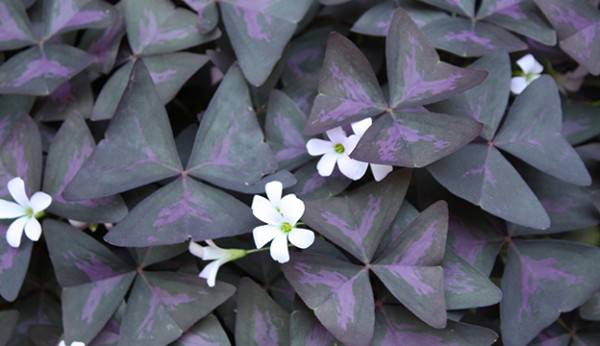
With St. Patrick’s Day sneaking up on us quickly, I thought it would be the perfect time to talk about growing shamrocks, or Oxalis.
These terrific plants shouldn’t be grown only for their significance to St. Patrick’s Day, though the green-leaved, white-flowered varieties are a common sight at flower shops and grocery stores in March. There are dozens of different cultivated varieties of Oxalis that make great garden and container plants. Some species are hardy in cold climates, but most are not. Non-hardy varieties are typically grown as annuals or overwintered indoors.
Also known as wood sorrel, Oxalis plants grow from bulbs and prefer partial shade during hot afternoon summers. They also like growing in well-drained soil. They come in a broad range of unique foliage colors and can add a lot of pizzazz to the garden.
Choosing Shamrock Varieties
One of my favorite ornamental Oxalis varieties is O. regnellii Triangularis. This beautiful plant has three-lobed, inch-wide leaves that are a deep purple with brighter-purple centers. The light-pink flowers stand above the foliage, making it a great choice for shady corners and containers. Silverado is another lovely cultivar with silvery foliage edged in deep green. The flowers on this variety are white. One called Iron Cross has leaves with four lobes that are green with a dark-red center. And, of course, there are many other varieties that might strike your fancy.
Overwintering Shamrocks Indoors
Here in my hardiness-zone-5 garden, the Oxalis varieties I grow are not hardy, so I have to overwinter the plants indoors. Sometimes I do this by growing the shamrocks as a houseplant on a sunny windowsill. After a few weeks of indoor growth, the plants will need to shift into a dormancy period.
The dormancy period is necessary for the plants to return to leaf and bloom at the start of the next gardening season. To shift the plants into dormancy, I stop watering and allow the plants to completely die back. The pot is totally bare, but the Oxalis bulbs are still nestled safely beneath the soil surface, waiting to sprout again in early spring. I begin to water dormant plants again in late February or early March, so they’re in leaf and ready to go back outside as soon as the danger of frost has passed.
The other way to overwinter Oxalis is to dig up the bulbs in the fall, before a frost, (the bulbs, strangely enough, often look like small pebbles or even sticks) and store them like a dahlia tuber. I spread the freshly dug bulbs out on a screen in the garage for a day or two then pack them into a cardboard box filled with very slightly damp peat moss. I break the bulbs apart before packing them away, but you may prefer to divide them in the spring when replanting.
Replanting Shamrock Bulbs In Spring
When spring arrives, I plant the bulbs back outdoors in late April. Or, if I want to get a jump-start on the growing season, I pot some of the bulbs up in small pots of potting soil in early March and grow them on a sunny windowsill to give them a bit of a head start. Whether planting the bulbs in containers or in the ground, be sure the tiny growing point is pointing up, and site them in a well-drained area where they’ll receive about a half day of sun.
Unfortunately, there are plenty of weedy species of Oxalis—you’d readily recognize the tiny yellow flowers of some of the weedy types growing in your lawn—but the ornamental varieties are well-worth growing.




